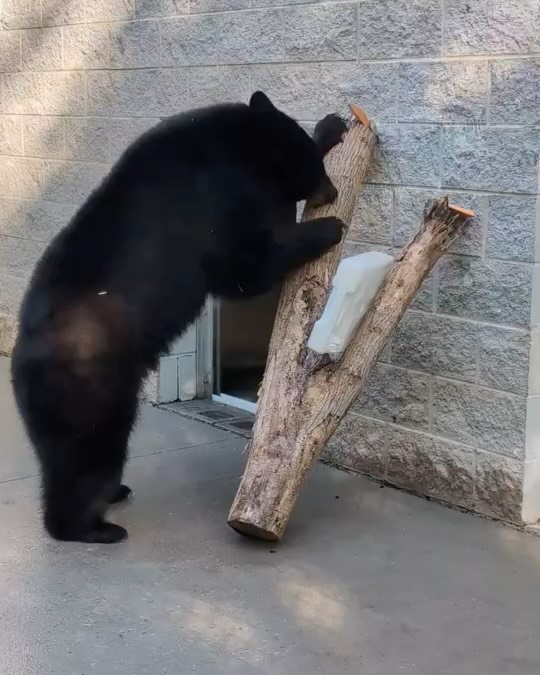- Exploring the innovative approach to animal enrichment through "It’s ants on a(n actual) log."
- Understanding the significance of natural foraging behaviors in bears within zoo environments.
- Examining the impact of enrichment activities on the physical and psychological well-being of American black bears.
- Discussing the role of zoo management and animal care in wildlife conservation efforts.
- Highlighting the balance between entertainment and education in contemporary zoo settings.
Animal enrichment is an essential aspect of modern zoo management, contributing significantly to the psychological and physical welfare of captive animals. One intriguing development in this area is the introduction of “It’s ants on a(n actual) log” by Animal Care, a creative twist on the classic children’s snack, designed specifically for American black bears. This approach not only stimulates the bears’ natural instincts but also serves as a valuable educational tool for observers.
The core of this enrichment technique involves the preparation of large pieces of wood. These logs are drilled with holes, into which various treats are inserted. The configuration invites bears to engage their natural foraging skills, using their long tongues or claws to extract the treats. This process mimics the intricate challenges bears face in the wild, ensuring a more engaging and dynamic interaction with their environment.
Natural foraging is a pivotal behavior for bears and other wildlife. In the wild, bears dedicate a significant portion of their time to searching for food, a necessity for their survival. This constant search for nourishment helps maintain their physical health, stimulating both body and mind. By facilitating similar experiences within a zoo setting, Animal Care encourages the bears to exercise their natural behaviors, promoting their overall well-being.
Zoo enrichment activities like this one play a critical role in the animals’ psychological health. For instance, when a bear engages with a log filled with treats, it experiences a series of cognitive challenges and rewards. This interaction can reduce stress, prevent boredom, and decrease the likelihood of stereotypic behaviors, such as pacing or over-grooming, commonly seen in captive animals lacking stimulation.
The logistics of implementing such enrichment activities demand careful planning and creativity from zoo staff. These activities are part of broader environmental enrichment programs, which are carefully designed to cater to the specific needs of each species. For American black bears, the variety provided by alternating feeding times and locations within their enclosures ensures continuous intrigue and engagement.
Zoo management is deeply invested in enhancing the lives of captive animals. This is evident in the attention to detail involved in crafting such innovative enrichments. Additionally, these initiatives reflect a commitment to wildlife conservation, as they allow animals to express behaviors crucial to their survival in the wild. By fostering these natural behaviors, zoos not only support the health of their charges but also contribute valuable insights into the natural history and ecological needs of species.
Incorporating enrichment strategies like “It’s ants on a(n actual) log” also serves an educational purpose. Visitors observing the bears interact with the logs gain a better understanding of wild behaviors and the challenges animals face in natural habitats. This educational component enhances the visitors’ appreciation of wildlife conservation efforts and the need for habitat preservation.
Moreover, these activities strike a delicate balance between entertainment and education for the public. Engaging exhibits draw in visitors, which is crucial for generating support and funding for zoo programs and conservation initiatives. Meanwhile, they offer an opportunity to educate the public about important ecological concepts and conservation strategies.
Animal Care’s inventive enrichment methods represent a crucial convergence of zoological science, wildlife conservation, and public education. Through such initiatives, zoos continue to evolve as platforms for environmental stewardship, showcasing the dynamic relationship between humans, technology, and nature. This ongoing evolution not only benefits the animals but plays a pivotal part in cultivating a more informed and conscientious society.
As zoos strive to mimic the complexities of natural ecosystems, they provide invaluable experiences for both animals and humans. The introduction of “It’s ants on a(n actual) log” exemplifies how simple yet thoughtful innovations can significantly enrich the lives of captive animals. Through these efforts, zoos contribute meaningfully to the global conversation on biodiversity and conservation, forging connections that inspire action and awareness for the natural world.
*****
Source Description
It’s ants on a(n actual) log! 🐻🐜
Animal Care innovated this more natural version of the classic peanut butter and raisin snack by drilling holes into some large pieces of wood. The bears use their long tongues to scoop items out of the holes or their claws to peel back the bark to look for food, encouraging instinctual foraging behavior!
In order to keep them guessing, Little Bear and our other American black bears receive a variety of enrichment at different times of day. Recently Little received this treat behind-the-scenes at the bears’ night house.
📹: Animal Care Shayna


